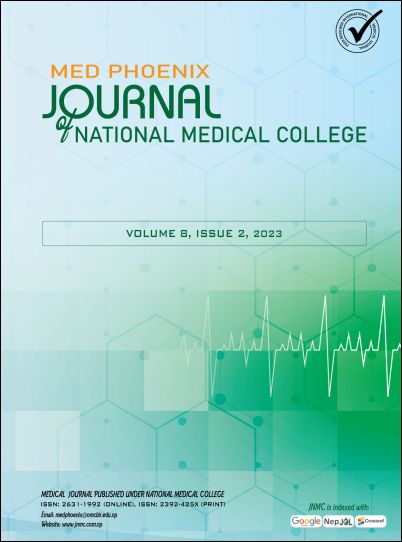Functional Outcome of Locking Compression Plate in Distal Femur Fractures
DOI:
https://doi.org/10.3126/medphoenix.v8i2.61825Keywords:
AO Muller Classification, DF-LCP, Distal femoral fracture, Neer’s ScoringAbstract
Introduction: Distal femur fracture is common in young people with high velocity injury. Management of distal femur fractures is a therapeutic challenge in orthopedics practice due to its extensive soft tissue injuries, bone loss, comminution, articular extension, instability.Open reduction with internal fixation replaces previous trend of closed conservative management and external fixation. Distal femoral locking compression plate (DF-LCP) requires both locking and compression screw fixation of the femur shaft. DF-LCP has been rapidly adopted as an alternative to intramedullary nails, blade plates and non-locking condylar screw.
Materials and Methods: Prospective interventional study was done in department of orthopedics at National Medical College and Teaching Hospital, Birgunj for one year among 45 patients of age more than 18 years with post traumatic closed or open GA Type I, II distal femur fractures, AO Muller type A and C fractures. Ethical approval was obtained from institutional review committee and proper informed consent was taken. Type of implant used was DF-LCP.NEER’S scoring system was used for
functional outcome.
Results: Out of 45 patients, 42 patients with distal femur fracture were treated by DF-LCP.Three patients lostduring follow up hence removed from study. Out of 42 patients, mean age of the patients was 36.62 years. Most of them 31, (73.8%) were male. Predominant fracture was on right side 29 (69%).The study finding showed that 30 (71.4%) sustained injury due to road traffic accidents. Most of the patients 18 (42.9%) had type A2 fracture according to AO Muller distal femur fracture classification. Complications like surgical site infection observed in 3 cases. 100% union rate achieved with an average union time of 17.26 weeks. On evaluation according to Neer’s criteria mean score was 82.1 (Range: 48-96). Out of 42 patients 24 (57%) had excellent, 14 (33%) had good, 3 (7.2%) had fair and 1 (2.4%) had poor result.
Conclusion: The study concluded DF-LCP is effective treatment for distal femur fracture. It provides stable construct for fracture union with excellent functional outcome.
Downloads
Downloads
Published
How to Cite
Issue
Section
License
Copyright (c) 2023 Med Phoenix

This work is licensed under a Creative Commons Attribution 4.0 International License.
Copyright on any research article is transferred in full to MED PHOENIX upon publication. The copyright transfer includes the right to reproduce and distribute the article in any form of reproduction (printing, electronic media or any other form).
© MEDPHOENIX
![]()
Articles in the MED PHOENIX are Open Access articles published under the Creative Commons CC BY License (https://creativecommons.org/licenses/by/4.0/). This license permits use, distribution and reproduction in any medium, provided the original work is properly cited.




